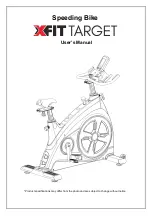
12) CONTROL DEVICES (Fig. H)
a – On/Off switch
b – Digital controller
13) DIGITAL CONTROLLER
The thermostat is already set at the factory. In case the temperature is
altered, the manufacturer will not take any responsibility. Any modification
will have to be made by qualified people.
14) TEMPERATURE
The thermostat regulates the temperature into the equipment and the
working temperature is already preset at the factory.
A lower performance must be expected from the refrigerated unit when:
- the equipment is set on the lowest temperature
- the equipment is positioned in an ambient with higher temperature or
relative humidity than above indicated
- the amount of displayed goods exceeds the maximum recommended and
the proper air circulation is prevented.
In those cases the goods are kept at higher temperatures, the refrigerating
unit has to run non-stop and ice may form on the evaporator. It is
necessary therefore to turn the equipment off to allow the complete
melting of the ice. During this phase do not use any kind of sharp object to
make the melting of the ice quicker, because you could cause big damages
to the equipment. Once the ice is completely melted, switch the
equipment on through the ON/OFF switch (as indicated in paragraph 10).
15) DEFROSTING
The defrosting takes place automatically during the running of the unit. The
defrosting cycles are 6 a day and last for about 25’ each. During the
defrosting phase the temperature of the unit could be altered, but when
this cycle is over, in a short time the working temperature will return to
normal.
The water from defrost is collected in a drip tray equipped with electric
evaporation.
16) PERIODICAL MAINTENANCE AND CLEANING
We suggest to carry out regularly a thorough cleaning of the cabinet
for
the good working, the good preservation of the food and the aesthetics
preservation of the equipment. The periodical cleaning
has to be made by qualified people, who should know the procedure
described in this paragraph.
Attention! Before starting any cleaning operation it is necessary to turn off
the equipment by the on/off red switch and to unplug or disconnect the
equipment by the general power security switch of your shop.
OBLIGATION
IMPORTANT – DURING THE WHOLE CLEANING
OPERATION USE WORKING GLOVES OF CLASS II TO
PROTECT YOUR HANDS ALL THE TIME.
Remove all goods from the refrigerated unit and keep them in a
fridge or in a refrigerated ambient suitable for their preservation.
Carefully and thoroughly clean the display surface, the glasses,
the aluminium profiles with specific cleaners for any surface.
PROHIBITION
During the maintenance and cleaning it is forbidden to use abrasive
substances, metal pads or other stuff which can damage the unit (fig.I).
After every cleaning operation it is necessary to rinse with warm water and
dry the unit with a soft cloth.
Clean the condenser, after having removed the cover grid (fig. L), with a dry
paint brush (do not use iron brushes - fig. I) or a vacuum cleaner, removing all
dust and possible deposits on the fins.
ATTENTION
During the maintenance and cleaning pay attention not to bend or
damage the fins and the whole refrigerating unit.
Never neglect this operation, as it is basic for the good working of
the unit and to avoid possible breakings. When you have finished
this operation, fit the cover grid in its original position.
When the cleaning operation is over, make sure that everything is
clean and dry before connecting the equipment to the power
supply again. When the unit reaches the correct working
temperature, it is possible to reload it.
17) TECHNICAL ASSISTANCE (servicing)
ATTENTION
If the equipment does not run properly or does not work at all, in your
own interest before calling for servicing, we suggest to check the
following points.
- if the plug is well inserted in the socket;
- if the power reaches the socket to which the equipment is connected;
- if the thermostat is set as recommended;
- if the network voltage is the same as requested for the equipment
(+-6%);
- if the evaporator is covered with ice (in this case proceed as indicated
at paragraph 14);
- if the condenser is clean (paragraph 16);
- if there are air draughts, if the cabinet is installed in the correct
position (see paragraph 8) and if the ambient temperature is as
indicated (see paragraph 7).
18) EMERGENCY SITUATIONS
Devices to be used in case of fire: powder-extinguishers or liquid-
extinguishers complying with the current legislation.
OBLIGATION
IN CASE OF REQUEST FOR SERVICE, CONTROL AND/OR
REPLACEMENTS YOU WILL HAVE TO CONTACT THE
SUPPLIER WHERE THE CABINET WAS BOUGHT.
ATTENTION
The loading line is indicated by a label applied on the glass (fig. G). In
case the label is damaged or replaced, the loading line has to be
indicated at 15 cm.
b) place the products in a regular way, without leaving empty spaces;
c) make a correct rotation of the foodstuffs, taking away first the products
that have been staying inside the cabinet for longer time.
In case of long absences (i.e. holidays etc.) the unit has to be unplugged,
emptied completely, cleaned and dried to prevent bad smells.
A correct maintenance of the equipment can considerably prolong its life.












































